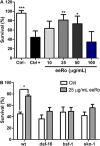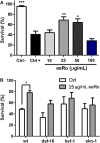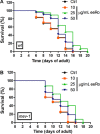Rosmarinus officinalis L. increases Caenorhabditis elegans stress resistance and longevity in a DAF-16, HSF-1 and SKN-1-dependent manner
- PMID: 27533765
- PMCID: PMC4988476
- DOI: 10.1590/1414-431X20165235
Rosmarinus officinalis L. increases Caenorhabditis elegans stress resistance and longevity in a DAF-16, HSF-1 and SKN-1-dependent manner
Abstract
Improving overall health and quality of life, preventing diseases and increasing life expectancy are key concerns in the field of public health. The search for antioxidants that can inhibit oxidative damage in cells has received a lot of attention. Rosmarinus officinalis L. represents an exceptionally rich source of bioactive compounds with pharmacological properties. In the present study, we explored the effects of the ethanolic extract of R. officinalis (eeRo) on stress resistance and longevity using the non-parasitic nematode Caenorhabditis elegans as a model. We report for the first time that eeRo increased resistance against oxidative and thermal stress and extended C. elegans longevity in an insulin/IGF signaling pathway-dependent manner. These data emphasize the eeRo beneficial effects on C. elegans under stress.
Figures





References
-
- Sotelo-Felix JI, Martinez-Fong D, Muriel P, Santillan RL, Castillo D, Yahuaca P. Evaluation of the effectiveness of Rosmarinus officinalis (Lamiaceae) in the alleviation of carbon tetrachloride-induced acute hepatotoxicity in the rat. J Ethnopharmacol. 2002;81:145–154. doi: 10.1016/S0378-8741(02)00090-9. - DOI - PubMed
MeSH terms
Substances
LinkOut - more resources
Full Text Sources
Other Literature Sources
Miscellaneous

